Clinical neurology for medical students. Follow Clinical neurology with KD podcast in Apple, Spotify and Google podcast. For live classes follow neurology teaching club in clubhouse
Don't wanna be here? Send us removal request.
Text
0 notes
Photo
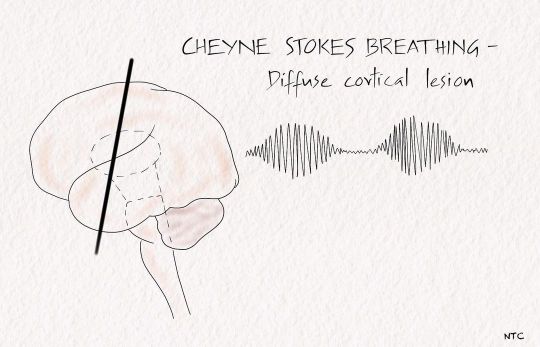
Respiratory abnormalities in coma. The full details are available in episode 13 of ‘Clinical neurology with KD’ podcast. Cheyne -stokes breathing. There are brief periods of hyperpnoea regularly alternating with an even shorter duration of apnoea. After the apneic phase, respiratory movement's amplitude increases to a peak before slowly waning off to the following apnea. It represents a more severe degree of normal post-hyperventilation apnea due to bilateral cortical dysfunction. Brainstem hyperventilation Patients with midbrain and pontine lesions can have rapid and prolonged hyperventilation. Lowering the local CSF pH and stimulating the respiratory centre of the medulla is one of the postulated mechanisms. Kussmaul's breathing is deep, rapid breathing seen in metabolic acidosis. Apneustic breathing In apneustic breathing, there is a prolonged inspiratory time followed by a long inspiratory pause. The air is retained for several seconds and released. The expiratory time is short, and a pontine lesion usually causes it. Cluster breathing It is a cluster of breaths following each other in an irregular sequence. It results from low pontine or high medullary lesions. Ataxic breathing The breathing pattern is entirely irregular. It is called the atrial fibrillation of breathing. The inspiration is of different amplitudes and lengths and intermixed with variable periods of apnea. It is often seen in terminally ill patients and suggests impending respiratory failure. The site of the lesion is the dorsomedial medulla. A paramedian medullary infarct, bleed, or tumour can produce it. The classical breathing described by Biot in severe meningitis is ataxic. Central hypoventilation The pathway of voluntary respiration from the cortex descends via the corticospinal tract. The automatic respiration fibres from the medulla descend in the ventrolateral cord, with anatomic separation of inspiratory and expiratory pathways. #neurology #neuroscience #coma #emergencymedicine #criticalcare #internalmedicine #neuro #neurologyteachingclub #clinicalneurology #respiration #respiratorymedicine #neurocriticalcare #neuroresident #medicineresidency #neetss https://www.instagram.com/p/ChEkwNAvGSl/?igshid=NGJjMDIxMWI=
#neurology#neuroscience#coma#emergencymedicine#criticalcare#internalmedicine#neuro#neurologyteachingclub#clinicalneurology#respiration#respiratorymedicine#neurocriticalcare#neuroresident#medicineresidency#neetss
0 notes
Photo
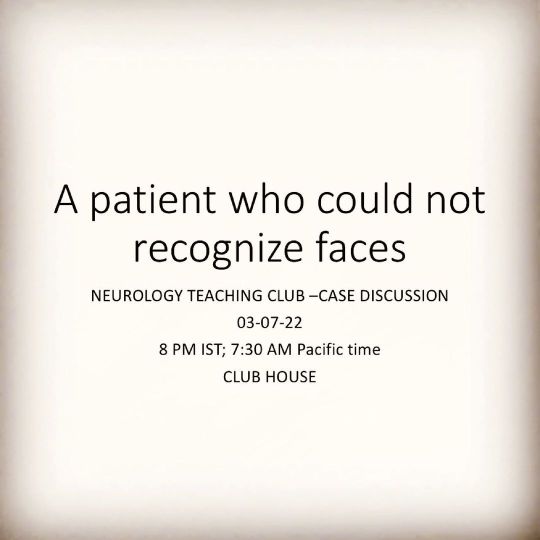
Neurology teaching club case presentation on clubhouse at 8 PM IST on 03/07/2022. A patient who could not recognise faces. #prosopagnosia #neurology #neuroscience #neurologyresident #neuroeducation #medicalstudent #medicaleducation #dementia #internalmedicineresidency #internalmedicine #bedsideteaching #clinicalcasediscussion #neurosurgery #medico #medicineresidency #medicineresidents https://www.instagram.com/p/CfijPGzLfPI/?igshid=NGJjMDIxMWI=
#prosopagnosia#neurology#neuroscience#neurologyresident#neuroeducation#medicalstudent#medicaleducation#dementia#internalmedicineresidency#internalmedicine#bedsideteaching#clinicalcasediscussion#neurosurgery#medico#medicineresidency#medicineresidents
0 notes
Photo
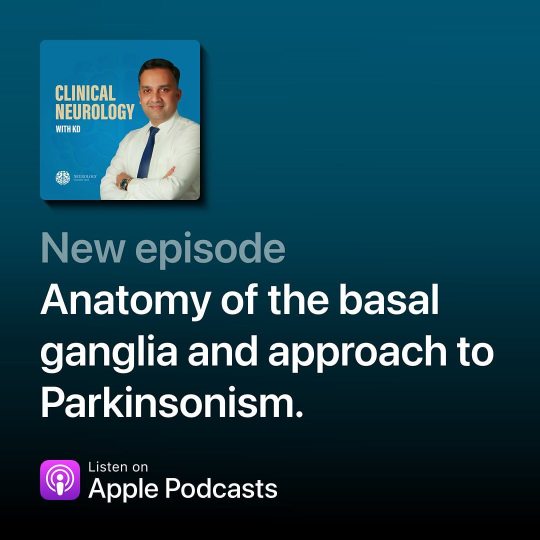
In this episode, we will discuss the anatomy and physiology of the basal ganglia. We will learn how to approach a patient with parkinsonism, one of the most common movement disorders. For notes and images of the episode, visit neurologyteachingclub.com. #neurology #neuroscience #neuro #internal medicine #medicalpodcast #emergencymedicine #emergencymedicineresidency #criticalcaremedicine #criticalcarenurse #movementdisorder #basalganglia #parkinsonism #ntc #neurologyteachingclub #neuroanatomy #neurophysiology #physiotherapy #physiatry #neuronurse #mbbs #medicos #generalpractitioner #medicineresidency #neurorehabilitacion #neuroresidency https://www.instagram.com/p/CeQQXhoLwm-/?igshid=NGJjMDIxMWI=
#neurology#neuroscience#neuro#internal#medicalpodcast#emergencymedicine#emergencymedicineresidency#criticalcaremedicine#criticalcarenurse#movementdisorder#basalganglia#parkinsonism#ntc#neurologyteachingclub#neuroanatomy#neurophysiology#physiotherapy#physiatry#neuronurse#mbbs#medicos#generalpractitioner#medicineresidency#neurorehabilitacion#neuroresidency
0 notes
Photo

Dermatomal supply For full discussion, hear episode 10 of the ‘Clinical neurology with KD’ podcast. Shoulder C3, C4, C5 ; Middle finger C7; Nipple T4; Umbilicus T10; Knee L3,L4; Sole of foot L4, L5, S1; Perianal S3, S4, S5 #neurology #neuronurses #neurosurgery #medico #medicalstudent #medicaleducation #sensory #dermatome #neetss #internalmedicine #neurologyteachingclub #NTC #paediatrics #paediatricneurology #criticalcare #criticalcaremedicine #emergencymedicine #mbbsstudent #thalamus #clinicalneurology #clinicalneurologywithkd #medicalpodcast #indiepodcast #generalpractitioner #continuingmedicaleducation https://www.instagram.com/p/CeJFi0UpnyJ/?igshid=NGJjMDIxMWI=
#neurology#neuronurses#neurosurgery#medico#medicalstudent#medicaleducation#sensory#dermatome#neetss#internalmedicine#neurologyteachingclub#ntc#paediatrics#paediatricneurology#criticalcare#criticalcaremedicine#emergencymedicine#mbbsstudent#thalamus#clinicalneurology#clinicalneurologywithkd#medicalpodcast#indiepodcast#generalpractitioner#continuingmedicaleducation
0 notes
Photo

Extra medullary compression of the spinal cord. For discussion of these images, follow episode five and six of podcast ‘Clinical neurology with KD’ in Apple podcast, Spotify or Google podcast. An extramedullary compressive lesion goes through three stages, according to Oppenheim. An initial stage of radicular pain and segmental motor and sensory symptoms. The initial phase is followed by a Brown-Sequard syndrome and finally a complete transection of the cord. The rapidity of development of these stages depends on the aetiology and can be acute or chronic. Some of the cardinal features of extramedullary compression include Radicular or root pain, which is a unilateral lancinating pain down the dermatome on coughing, straining, or Valsalva. The patient will have early corticospinal tract involvement with lower limb spasticity more than the upper limb. The leg is more involved as leg fibres are laterally placed in the corticospinal tract than arm fibres. The LMN findings are rare and, if present, occur at the segmental level at the site of compression. The patient will have only late bladder involvement. They have ascending paresthesia as sacral fibres are laterally placed in the spinothalamic tract. Funicular or tract pain is less common. The patient can have vertebral pain and tenderness, which suggest extramedullary extradural lesion. #clinicalneurologywithkd #neurologyteachingclub #paediatricneurology #NTC #neurology #neurosciences #neuro #clinicalneurology #medicine #clinicalmedicine #criticalcaremedicine #mbbs #medicos #doctors #neuroanatomy #casediscussion #medicineresidents #residency #medschool #futureneurologist #neuroimages #NEET #finalmbbs #neetpg #neetsuperspeciality #neetmedicine #eanneurology #nejm #emergencymedicine #spinalcord https://www.instagram.com/p/Cds4asLpst1/?igshid=NGJjMDIxMWI=
#clinicalneurologywithkd#neurologyteachingclub#paediatricneurology#ntc#neurology#neurosciences#neuro#clinicalneurology#medicine#clinicalmedicine#criticalcaremedicine#mbbs#medicos#doctors#neuroanatomy#casediscussion#medicineresidents#residency#medschool#futureneurologist#neuroimages#neet#finalmbbs#neetpg#neetsuperspeciality#neetmedicine#eanneurology#nejm#emergencymedicine#spinalcord
0 notes
Photo

Vibration pathway. For discussion of these images, follow 'Clinical neurology with KD' podcast episode seven in Apple podcast, Spotify or Google podcast. Full notes are available on the neurologyteachingclub.com website. The receptors of vibration are rapidly adapting mechanoreceptors like Pacinian corpuscle. The Merkel disk receptors and Meissner corpuscles respond best to relatively low frequencies while Pacinian corpuscles to higher frequencies. Impulses are relayed with the proprioceptive and touch sensations through large, myelinated nerve fibres. They enter the spinal cord through the medial division of the posterior root. It ascends in the spinal cord through multiple pathways, namely posterior column-medial lemniscus and dorsolateral funiculus. The fibres in the dorsolateral funiculus may be the most crucial pathway subserving vibratory sensation in man. Axons of the second-order neurons in the posterior horn ascend in the spinocervical tract in the ipsilateral dorsolateral funiculus. It terminates in the lateral cervical nucleus. Axons from neurons in the lateral cervical nucleus cross in the anterior commissure and ascend to the medulla, where they join the ML. Though some JPS fibres also ascend through this pathway, this divergence of the position sense and vibration sense pathways partially explains the dissociation occasionally encountered clinically between JPS and vibration. #clinicalneurologywithkd #neurologyteachingclub #neurologypodcast #NTC #neurology #neurosciences #neuro #clinicalneurology #medicine #clinicalmedicine #kdpodcast #mbbs #medicos #doctors #neuroanatomy #casediscussion #medicineresidents #residency #medschool #futureneurologist #neuroimages #NEET #finalmbbs #neetpg #neetsuperspeciality #neetmedicine #eanneurology #nejm #vibration #sensory https://www.instagram.com/p/CdauRhXJQe-/?igshid=NGJjMDIxMWI=
#clinicalneurologywithkd#neurologyteachingclub#neurologypodcast#ntc#neurology#neurosciences#neuro#clinicalneurology#medicine#clinicalmedicine#kdpodcast#mbbs#medicos#doctors#neuroanatomy#casediscussion#medicineresidents#residency#medschool#futureneurologist#neuroimages#neet#finalmbbs#neetpg#neetsuperspeciality#neetmedicine#eanneurology#nejm#vibration#sensory
0 notes
Photo
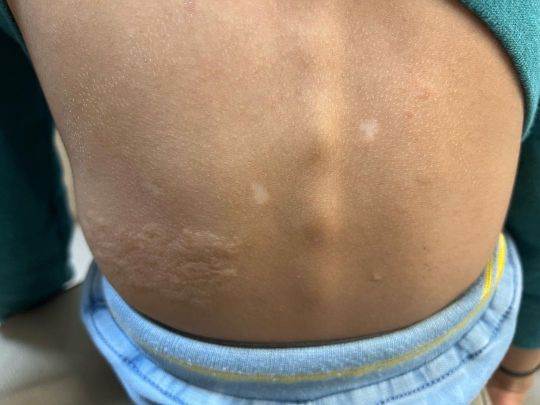
🚨Spotter🚨Five year old boy came with episodes of stare of few seconds. He won’t respond to call at that time. Diagnosis was made from general examination. Please DM me the answers. Follow Clinical neurology with KD podcast at Apple podcast, Google Podcast and Spotify. #clinicalneurologywithkd #neurologyteachingclub #neurologypodcast #NTC #neurology #neurosciences #neuro #clinicalneurology #medicine #clinicalmedicine #kdpodcast #mbbs #medicos #doctors #neuroanatomy #casediscussion #medicineresidents #residency #medschool #futureneurologist #neuroimages #NEET #finalmbbs #neetpg #neetsuperspeciality #neetmedicine #eanneurology #nejm #seizure #epilepsy. https://www.instagram.com/p/CdJKLJOvxO8/?igshid=NGJjMDIxMWI=
#clinicalneurologywithkd#neurologyteachingclub#neurologypodcast#ntc#neurology#neurosciences#neuro#clinicalneurology#medicine#clinicalmedicine#kdpodcast#mbbs#medicos#doctors#neuroanatomy#casediscussion#medicineresidents#residency#medschool#futureneurologist#neuroimages#neet#finalmbbs#neetpg#neetsuperspeciality#neetmedicine#eanneurology#nejm#seizure#epilepsy
0 notes
Photo

The sensory pathways. For full discussion of this image, follow 'Clinical neurology with KD' podcast episode 10 in Apple podcast, Spotify or Google podcast. Full notes are available on the neurologyteachingclub.com website. The primary modalities of sensation, including touch, pain, temperature, JPS, and vibration, are recognised at the level of the opposite thalamus. So all these sensations are carried to the opposite thalamus by the sensory pathways. The fine touch, vibration and JPS ascend in the posterior column- medial lemniscus pathway, while the pain and temperature through the lateral spinothalamic tract. From the thalamus, they are then projected to the sensory cortex in the postcentral gyrus through the posterior limb of the internal capsule. The sensory cortex helps identify the cortical sensations, namely tactile localisation, two-point discrimination, graphesthesia, stereognosis and sensory attention. #clinicalneurologywithkd #neurologyteachingclub #neurologypodcast #NTC #neurology #neurosciences #neuro #clinicalneurology #medicine #clinicalmedicine #kdpodcast #mbbs #medicos #doctors #neuroanatomy #casediscussion #medicineresidents #residency #medschool #futureneurologist #neuroimages #NEET #finalmbbs #neetpg #neetsuperspeciality #neetmedicine #eanneurology #nejm #aanbrain #neuroimage https://www.instagram.com/p/CdI1u4oP9cY/?igshid=NGJjMDIxMWI=
#clinicalneurologywithkd#neurologyteachingclub#neurologypodcast#ntc#neurology#neurosciences#neuro#clinicalneurology#medicine#clinicalmedicine#kdpodcast#mbbs#medicos#doctors#neuroanatomy#casediscussion#medicineresidents#residency#medschool#futureneurologist#neuroimages#neet#finalmbbs#neetpg#neetsuperspeciality#neetmedicine#eanneurology#nejm#aanbrain#neuroimage
1 note
·
View note
Photo
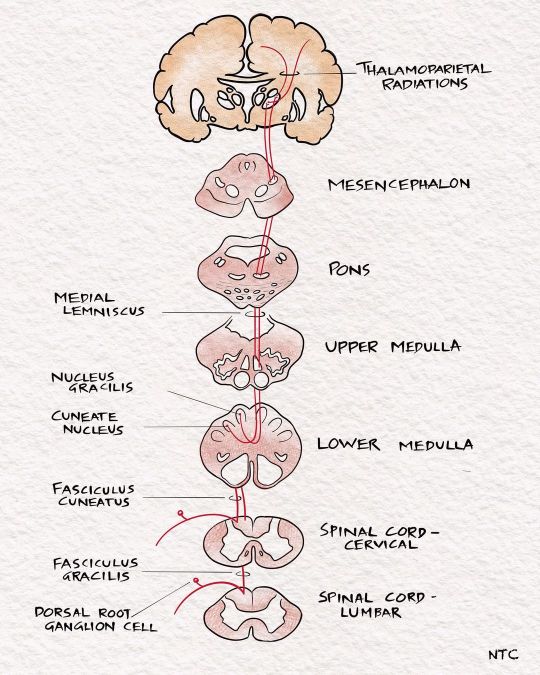
Light touch pathway For discussion of these image, follow 'Clinical neurology with KD' podcast episode ten in Apple podcast, Spotify or Google podcast. Full notes are available on the neurologyteachingclub.com website. The receptors for touch sensation include free nerve endings, Merkel cell endings, and encapsulated nerve endings such as Meissner's corpuscles, Pacinian corpuscles and Ruffini endings. The Pacinian corpuscles act as rapidly adapting mechanoreceptors and are especially sensitive to high-frequency vibration. Others are slowly adapting mechanoreceptors. Light touch sensation is conveyed over large myelinated peripheral nerve fibres to unipolar DRG cells. Tactile sensation follows several different pathways within the central nervous system. The central processes of DRG enter the spinal cord via the medial division of the posterior roots. It then projects through the ipsilateral posterior column to reach the cervicomedullary junction. The fibres from the sacral area will be arranged most medially in the posterior column. The lumbar will be just lateral, followed by the thoracic. The cervical fibres are lateral most as they are the last to enter while going up. The second-order neuron lies in the cuneatus and gracillis nucleus at the cervicomedullary junction. All the fibres below T8 are grouped in the fasciculus gracilis; fibres above T8 form the fasciculus cuneatus. The second-order neurons in the nucleus cuneatus and gracillis project to the opposite thalamus. They immediately sweep anteriorly as the internal arcuate fibres and cross over to the opposite side at the cervicomedullay junction. It ascends in the brainstem as the medial lemniscus to reach the thalamus. The Third-order neuron lies in the ventral posterolateral nucleus of the thalamus and project to the sensory cortex. #sensory #touchpathway #neuro#neurologyteachingclub #neurologypodcast #NTC #neurology #neurosciences #neuro #clinicalneurology #medicine #clinicalmedicine #kdpodcast #mbbs #medicos #doctors #neuroanatomy #casediscussion #medicineresidents #residency #medschool #futureneurologist #neuroimages #NEET #finalmbbs #neetpg https://www.instagram.com/p/CdDx2tIvefO/?igshid=NGJjMDIxMWI=
#sensory#touchpathway#neuro#neurologyteachingclub#neurologypodcast#ntc#neurology#neurosciences#clinicalneurology#medicine#clinicalmedicine#kdpodcast#mbbs#medicos#doctors#neuroanatomy#casediscussion#medicineresidents#residency#medschool#futureneurologist#neuroimages#neet#finalmbbs#neetpg
1 note
·
View note
Photo
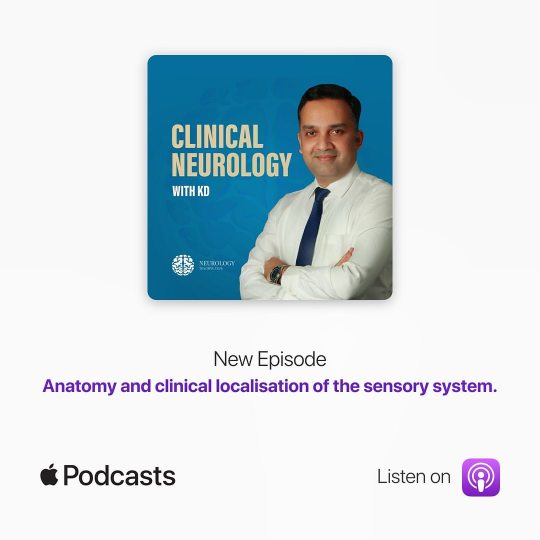
New episode of the podcast’Clinical neurology with KD’ released. In this episode, we will discuss the clinical localisation of sensory symptoms. We will learn the sensory pathways and study the clinical features of lesions involving these pathways. You can hear it at Apple podcast, Spotify or wherever you get your podcast #clinicalneurologywithkd #neurologyteachingclub #neurologypodcast #NTC #neurology #neurosciences #neuro #clinicalneurology #medicine #clinicalmedicine #kdpodcast #mbbs #medicos #doctors #neuroanatomy #casediscussion #medicineresidents #residency #medschool #futureneurologist #neuroimages #NEET #finalmbbs #neetpg #neetsuperspeciality #neetmedicine #eanneurology https://www.instagram.com/p/CdACTF5PaTR/?igshid=NGJjMDIxMWI=
#clinicalneurologywithkd#neurologyteachingclub#neurologypodcast#ntc#neurology#neurosciences#neuro#clinicalneurology#medicine#clinicalmedicine#kdpodcast#mbbs#medicos#doctors#neuroanatomy#casediscussion#medicineresidents#residency#medschool#futureneurologist#neuroimages#neet#finalmbbs#neetpg#neetsuperspeciality#neetmedicine#eanneurology
0 notes
Photo
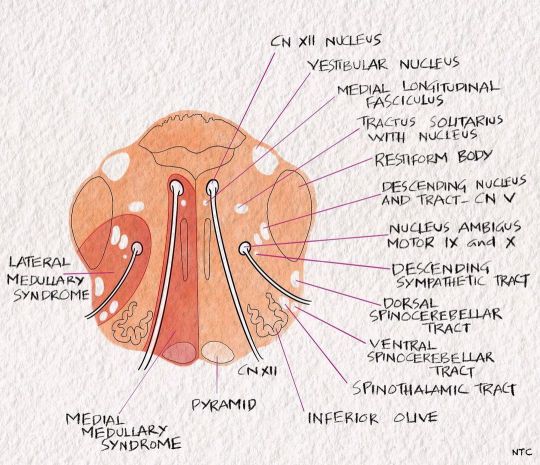
Medial medullary syndrome of Dejerine The 'rule of four' tells us that the 4M lies medially in the brainstem, including the motor pathway or pyramidal tract, motor nuclei of hypoglossal, medial lemniscus and medial longitudinal fasciculus. So a medial medullary syndrome produces opposite side weakness with loss of posterior column sensation and ipsilateral hypoglossal nerve palsy. The MLF involvement can cause upbeat nystagmus occasionally. #clinicalneurologywithkd #neurologyteachingclub #neurologypodcast #NTC #neurology #neurosciences #neuro #clinicalneurology #medicine #clinicalmedicine #kdpodcast #mbbs #medicos #doctors #neuroanatomy #casediscussion #medicineresidents #residency #medschool #futureneurologist #neuroimages #NEET #finalmbbs #neetpg #neetsuperspeciality #neetmedicine #eanneurology #nejm #aanam #medulla https://www.instagram.com/p/Cc2uhA7PxCd/?igshid=NGJjMDIxMWI=
#clinicalneurologywithkd#neurologyteachingclub#neurologypodcast#ntc#neurology#neurosciences#neuro#clinicalneurology#medicine#clinicalmedicine#kdpodcast#mbbs#medicos#doctors#neuroanatomy#casediscussion#medicineresidents#residency#medschool#futureneurologist#neuroimages#neet#finalmbbs#neetpg#neetsuperspeciality#neetmedicine#eanneurology#nejm#aanam#medulla
0 notes
Photo

Ventral or anterior pontine lesions For full discussion of the image hear ‘Clinical neurology with KD’ 🎙podcast episode 9. The link is given in the profile. The ventral pontine lesions include Millard-Gubler, Raymond, lacunar syndromes, and Locked in state. Millard- Gubler syndrome A unilateral lesion in the basis pontis in the ventral-caudal pons involving the 6th CN and 7th CN fascicle and corticospinal tract results in Millard-Gubler. The patient will have ipsilateral 6th and 7th CN palsy with contralateral hemiplegia. Raymond syndrome A lesion in ventral medial pons involving the 6th CN fascicle and corticospinal tract. The patient will have ipsilateral lateral rectus palsy with contralateral hemiplegia. Lacunar syndromes Small infarcts in the basis pontis can produce lacunar syndromes similar to those described in the internal capsule lesion. Basis pontis lesions can produce pure motor hemiparesis, ataxic hemiparesis and dysarthria clumsy hand syndrome. Locked-in syndrome. Bilateral extensive ventral pontine lesion produces a locked-in state. The aetiology may be infarct, demyelination, central pontine myelinolysis etc. The patient will have quadriparesis due to the bilateral corticospinal tract involvement. The patient will have aphonia due to bilateral corticobulbar involvement. The patient will be fully conscious as the reticular activation system, located dorsally, is spared. The patient can communicate through eye blinks. #clinicalneurologywithkd #neurologyteachingclub #neurologypodcast #NTC #neurology #neurosciences #neuro #clinicalneurology #medicine #clinicalmedicine #pons #mbbs #medicos #doctors #neuroanatomy #casediscussion #medicineresidents #residency #medschool #futureneurologist #neuroimages #NEET #finalmbbs #neetpg #neetsuperspeciality #neetmedicine #eanneurology #nejm #aanbrain #neuroimage https://www.instagram.com/p/CcfurdVP-P3/?igshid=NGJjMDIxMWI=
#clinicalneurologywithkd#neurologyteachingclub#neurologypodcast#ntc#neurology#neurosciences#neuro#clinicalneurology#medicine#clinicalmedicine#pons#mbbs#medicos#doctors#neuroanatomy#casediscussion#medicineresidents#residency#medschool#futureneurologist#neuroimages#neet#finalmbbs#neetpg#neetsuperspeciality#neetmedicine#eanneurology#nejm#aanbrain#neuroimage
0 notes
Photo

Parinaud's syndrome. For full discussion of the image hear ‘Clinical neurology with KD’ 🎙podcast episode 9. The link is given in the profile. A dorsal rostral midbrain lesion causes it. The vertical gaze palsy is due to the involvement of riMLF and the Interstitial nucleus of Kajal in the thalamo-midbrain junction. The lid retraction and convergence retraction nystagmus are due to the loss of supranuclear inhibition to the third nerve nucleus. The light near dissociation is due to damage of the pretectal nucleus or the decussating fibres of the pretectal nucleus in the posterior commissure. The pupillary reflex will be absent, while the accommodation reflex will be present. The accommodation reflex is preserved because the accommodation pathway enters the Edinger- Westphal nucleus more ventrally. #clinicalneurologywithkd #neurologyteachingclub #neurologypodcast #NTC #neurology #neurosciences #neuro #clinicalneurology #medicine #clinicalmedicine #kdpodcast #mbbs #medicos #doctors #neuroanatomy #casediscussion #medicineresidents #residency #medschool #futureneurologist #neuroimages #NEET #finalmbbs #neetpg #neetsuperspeciality #neetmedicine #eanneurology #nejm #aanbrain #neuroimage https://www.instagram.com/p/CcdZWYVvJfE/?igshid=NGJjMDIxMWI=
#clinicalneurologywithkd#neurologyteachingclub#neurologypodcast#ntc#neurology#neurosciences#neuro#clinicalneurology#medicine#clinicalmedicine#kdpodcast#mbbs#medicos#doctors#neuroanatomy#casediscussion#medicineresidents#residency#medschool#futureneurologist#neuroimages#neet#finalmbbs#neetpg#neetsuperspeciality#neetmedicine#eanneurology#nejm#aanbrain#neuroimage
4 notes
·
View notes
Photo

Cerebellar nuclei For full discussion of this topic, hear episode 8 of Clinical neurology with KD podcast at Apple podcast, Spotify or Google podcast. The cerebellar nuclei are the main source of cerebellar efferents. All of the efferent projections of the deep cerebellar nuclei are excitatory, except for projections to the inferior olive, which are inhibitory. These nuclei from medial to lateral include the fastigial nucleus, the nucleus interpositus (composed of the globose and emboliform nuclei), and the dentate nucleus. The arrangement can be remembered by the code Fast Girls Eat Dates. The fastigial nucleus assists stance and gait. Therefore its lesion may cause abasia. You can remember it by the code- Fast Gait. The nucleus interpositus assists segmental reflexes. It speeds the initiation of movements triggered by somatosensory cues. It guides the response, stop unwanted and promotes wanted oscillations. Therefore, nucleus- interpositus lesions may result in delayed check or rebound responses, truncal titubation, abnormal rapid alternating movements, action tremor, and ataxia on finger-nose-finger and heel-knee-shin manoeuvres. The dentate nucleus assists in tasks requiring fine dexterity. You can remember it like D for D [Dentate for Dexterity]. Lesions of this nucleus or its projections cause delays in initiating and terminating movements, terminal and intention tremors, temporal incoordination in activities that require multiple joints, and abnormalities in the spatial coordination of hand and finger movements. #clinicalneurologywithkd #neurologyteachingclub #neurologypodcast #NTC #neurology #neurosciences #neuro #clinicalneurology #medicine #clinicalmedicine #kdpodcast #mbbs #medicos #doctors #neuroanatomy #casediscussion #medicineresidents #residency #medschool #futureneurologist #neuroimages #NEET #finalmbbs #neetpg #neetsuperspeciality #neetmedicine #eanneurology #nejm #cerebellum #dnbneurology https://www.instagram.com/p/CbsjK-9vv0p/?utm_medium=tumblr
#clinicalneurologywithkd#neurologyteachingclub#neurologypodcast#ntc#neurology#neurosciences#neuro#clinicalneurology#medicine#clinicalmedicine#kdpodcast#mbbs#medicos#doctors#neuroanatomy#casediscussion#medicineresidents#residency#medschool#futureneurologist#neuroimages#neet#finalmbbs#neetpg#neetsuperspeciality#neetmedicine#eanneurology#nejm#cerebellum#dnbneurology
0 notes
Photo

I have joined Meitra Hospital, Kozhikode, Kerala as a consultant in neurology. We are starting the DNB neurology program at Meitra. Meitra has an excellent neurosciences team. Dr K A Salam, one of the seniormost and respected neurologists in the state, is the chairman of the neurosciences. Dr Sachin Sureshbabu, a dynamic leader and epileptologist, is our head of the department. He has been running a very successful epilepsy surgery program, which is not an easy thing to do in a private setup. Dr Deep P Pillai has joined us as our interventional neurologist. We did our DM neurology together at Trivandrum medical college. Deep was always passionate about intervention neurology, and after DM, he went for a 2-year training in intervention neurology. His presence will be a significant asset to our department. It will make Meitra one of the few centres in the country where neurology residents are given hands-on training in intervention by a trained neurologist. Dr Javed Ahamed is our Associate consultant in neurology. He is my MBBS batchmate and a wonderful human being. He is also keen on intervention neurology and, together with Deep, is planning to start the FNB neuro intervention program. Last but not least, Dr Poornima Narayanan is our lady superstar. She is a product of the Sree Chitra Tirunal Institute of medical science. A soft-spoken clinician par excellence, she is one of the pillars of our department. Myself is coordinating the academic activities of the residents. A vibrant neurosurgery team of experts backs us up. Our vision is to become one of the best DNB neurology training centres in the country. My dream is to see, one day, the first rank in Neurology super-speciality exam takes up the seat in Meitra. Well, sorry for that, I always have been a big dreamer. We have two seats this year. If any of your friends or colleagues plan to take up DNB neurology, please consider Meitra. They will be taught well. Dr Krishnadas N C MD DM. #dnbneurology #neetsuperspeciality #neetsuperspecialityonline #dmneurology #dmneurologycourse #dnb #dnbsuperspeciality https://www.instagram.com/p/CbmbMSkLvwM/?utm_medium=tumblr
#dnbneurology#neetsuperspeciality#neetsuperspecialityonline#dmneurology#dmneurologycourse#dnb#dnbsuperspeciality
0 notes
